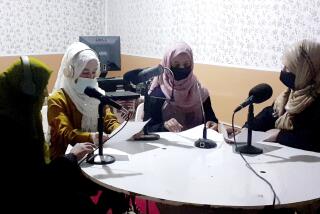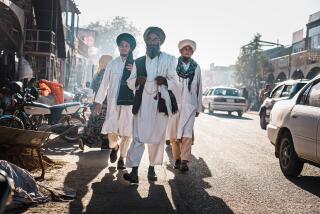U.S. Making Radio Waves in Mideast
- Share via
WASHINGTON — The United States will power up a new tool in its campaign to undermine the regimes in Iran and Iraq with the inauguration today of a radio transmitter in Kuwait that is 12 times more powerful than any allowed to operate in the U.S.
Economic sanctions, political isolation and a strong U.S. military presence in the region have failed to significantly alter the governments in either Tehran or Baghdad. To turn up the heat, the United States is now trying to appeal directly to local populations to promote political change.
“Information is a powerful weapon,” said Geoffrey Cowan, director of the Voice of America (VOA). “It’s always been true that the word is more powerful than the sword.
“So if getting information to people in Iran about democracy and human rights and about what’s happening inside their country and in the world makes a difference politically, then this will be a transmitter of tremendous importance,” he said.
The 600-kilowatt transmitter will be used primarily by the VOA. It will beam signals as far as Central Asia, the Indian subcontinent, the Persian Gulf and the eastern Mediterranean, making U.S. broadcasts available on home and car radios.
The biggest impact will be in Iran and Iraq, where audiences are expected to expand significantly because listeners will no longer need shortwave radios to pick up American broadcasts, U.S. officials said. Transmissions will be impossible to jam.
Iranian broadcasts currently dominate the airwaves in the region, and Washington has been unable to counter those broadcasts, largely due to poor access. The Kuwait facility marks a major breakthrough, because governments in the Persian Gulf long have denied U.S. requests to build such a medium-wave relay station.
The United States still will not outgun Iran. The Voice of the Islamic Republic of Iran has 13,500-kilowatt transmitters through which it has been broadcasting in 21 languages--from Arabic to Uzbek, English to Russian--for twice as many hours as the United States, according to the World Radio/TV Handbook.
In contrast, the VOA will broadcast from Kuwait in six languages, mainly English, Arabic and Persian, the primary language of Iran.
Iran’s programming has long been considered by U.S. and Persian Gulf region intelligence services to be a primary means for exporting its Islamic message. It has a wide following, particularly among Shiite Muslims in the Arabian Peninsula, Iraq and Lebanon, and Persian-speakers in Central Asia.
Alarm about Tehran’s capabilities led Sen. Alfonse M. D’Amato (R-N.Y.) to introduce legislation last year to establish Radio Free Iran as a counterpart to Radio Free Europe. The bill, now being reworked, calls for broadcasts largely of political news about Iran and the outside world.
Kuwait’s decision to allow the transmitter is widely seen as a payoff for U.S. leadership during the 1991 Persian Gulf War that liberated Kuwait from Iraqi occupation. But Kuwait is still uncomfortable about the U.S. facility, U.S. officials said.
The VOA has a significant audience in Iran, where at least 11% of the population of 64.7 million listens regularly, according to a 1994 survey conducted for the U.S. Information Agency.
The VOA is also the primary foreign news source in Iraq, where up to 20% of Iraqis are believed to listen frequently, according to Mohammed Ghuneim, director of the VOA Arabic Service. Over the past year, the VOA has significantly increased coverage of the Iraqi opposition, especially since a new movement was launched in neighboring Jordan.
“At the VOA, our aim is not to oust a regime,” Ghuneim said. “But we want to make people aware of what is going on, and then it’s up to them to change their own systems.”
More to Read
Sign up for Essential California
The most important California stories and recommendations in your inbox every morning.
You may occasionally receive promotional content from the Los Angeles Times.










